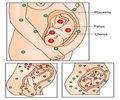A study to be presented on February 16 between 8 a.m., and 10 a.m. PST, at the Society for Maternal-Fetal Medicine's annual meeting, The Pregnancy Meeting ™, in San Francisco, researchers

"Many hospitals have moved toward adopting the laborist model, and it's critically important to determine whether it is improving pregnancy outcomes," explained Srinivas.
The study matched 8 laborist hospitals to 16 non-laborist hospitals accounting for location, volume of deliveries, the presence of a neonatal ICU and teaching status.
"The hospitals selected were diverse in terms of volume with 30 percent of the data coming from hospitals with more than 5,000 births a year, 44 percent from hospitals with 2,500 to 5,000 births per year and 25 percent from hospitals with less than a 2,500 births per year," said Srinivas.
The study showed that using the laborist model resulted in 15 percent fewer labor inductions, reduced maternal length of stay (0.09 days), and a significant reduction in preterm delivery (17 percent).
"We thought the laborist model would improve pregnancy outcomes and now we have data that demonstrates that," said Srinivas. We need to do more research to understand the mechanism by which these outcomes are improved but this is a start."
Advertisement
Source-Eurekalert














